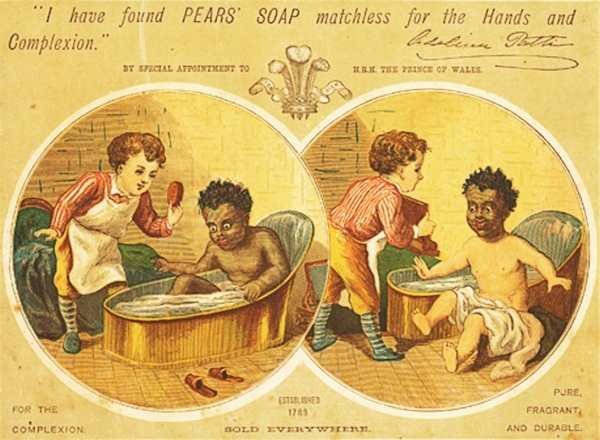- Chosen Question: “Which social groups are marginalized,
excluded or silenced within the text?” from the Power and Privilege
section.
- Text Title: An Advertisement for Pear’s Soap from
the 1920s.
- Part 2, language and mass communication.
- In this task I’ll be focusing on:
-
The
marginalization of blacks in the Pear’s advert
-
How
this is supported by the imagery and theme of the advertisement
-
How
the choice to marginalize this particular social group is reflective of issues
at the time
The advert:
Written
Task 2
Within this British advertisement for
Pear’s soap from the 1920s, we see the black social group being marginalized. This
is seen in a number of ways, but mainly through the stylistic characteristics
of the two main images used in the text.
Firstly, the presentation of the
black child as a caricature excludes people of dark skin by making them seem ‘abnormal’
compared to whites (as seen in the ‘normalcy’ of the white child). The black
toddler has huge, bulging eyes and thick, red lips that are greatly exaggerated
while also being visibly amazed at soap and water. The child is used for
comedic effect, and because he differs the greatest from the white child in his
skin colour, we see how he is being ridiculed based on his race. By
disregarding his dignity, this advert objectifies the black child.
The exclusion of the black child is
especially obvious due to the inclusion of a white child in the advert. By depicting both races, the children become
representative of their races – not just individual examples. As a result, the
earlier mockery of the black child is even starker, as it is made to apply to
everyone with dark skin by making them look savage and inadequate compared to
people with light skin. The blacks are marginalized by comparison.
Another way this is seen is in the
positioning of the children in relation to each other. The white toddler stands
over the black toddler in his bathtub, taking the role of caretaker or teacher.
This implies the white child having a greater intelligence to a black child. He
is also nicely dressed, while the black toddler is naked and in the vulnerable
position of taking a bath. This again emphasizes the power the whites had over
the blacks.
Of course, Pear’s uses all this
imagery of white being superior to black to their advantage by associating
themselves with being white. The white child is the one holding the Pear’s
soap, symbolizing that being ‘white’ is synonymous with cleanliness. The advert
also mentions twice that Pear’s soap is ‘for the complexion’, reiterating that
Pear’s makes you whiter and therefore cleaner. The choice of the Prince of
Wales to give them Ethos is also very significant – since the idea of nobility
is usually attached to being ‘pure-blooded’ and again makes Pear’s seem clean
and pure.
The plot of the advert, where the
white child cleans the black child and he emerges white and grateful at the
end, also supports the marginalization of blacks. It seems almost as if the
fair skinned people see themselves as being charitable, and are giving help to
those ‘worse off’ because of their skin colour. The reaction of the black child
suggests the white people wanted the blacks to feel grateful for what they had
done for them.
The choice of this particular
message of white superiority (that dark skinned people should accept help given
to them) is especially significant during the 1920s. Around this time, Gandhi
began preaching mass civil disobedience against the British rule in India,
where the authorities sentenced him to six years in prison. This advert may
have been a reflection of white opinion at the time – which held that dark
skinned people should just be grateful for the rule they were under (like the
baby in the ad), and stop trying to revolt.
In conclusion, the community of dark
skinned people is marginalized in this advert by being insulted and made to be ‘lesser’
than fair skinned people. By emphasizing that being white is pure and being
black/dark is the opposite, Pears excludes an entire social group, as they’re
made into objects to represent dirt.

No comments:
Post a Comment